Artistic director: Mareen Alburg-Duncker
Special school “Astrid Lindgren” in Halle
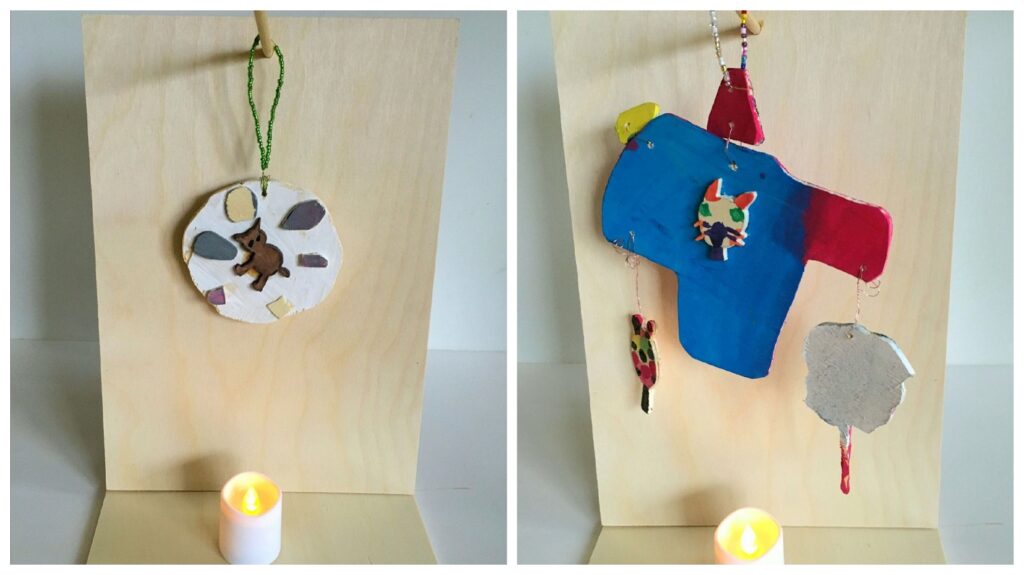
The joy of seeing the 6th grade again was great and motivation was high. Our theme this year was to create our own little oasis. The first question was – what is (my) oasis? And then we figured it out – they are feel-good places or things that you would like to do or have. The ideas ranged from baking cakes and playing soccer to flying like a bird. First sketches were made with colored pencils and paper. Once the shape had been transferred to the wooden panel, it was sawn with support. The parts were further processed with sandpaper, files and hand drills and then colored with brushes and paint. Further elements were made to decorate both sides of the basic shape. The cake was decorated with candles and flowers, for example. This resulted in three-dimensional objects.
The pupils threaded small glass beads onto wire with skill and patience. Finally, we built a wooden plate with an inserted round rod and base for each object. The object could now be attached. With an LED candle, it was put in the pre-Christmas light!
Artistic direction: Claudia Baugut
Levana School Eisleben
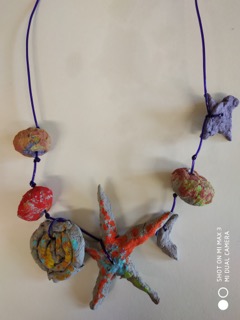
“Fish, stars, balls…” Creating jewelry with papier-mâchéWorking with mentally disabled pupils requires manageable impulses and tasks in simple steps and with sufficient time. Specially produced, partially pigmented papier-mâché was the starting material for the design of small plastic jewelry forms, which were painted after drying and arranged to form a necklace. This resulted in very imaginative, individual and cheerful works with a surprisingly unique language of color and form.
Artistic direction: Julia Baum and Sebastian Harwardt
Secondary school Albrecht Dürer Merseburg

Students from a year 10 class designed walls in the school building on the theme of “Underwater world”. After exploring various creatures in the (deep) sea together, the pupils drew animals and plants. The resulting drawings served as a direct template and were traced onto the walls with chalks, transferred freehand or enlarged with auxiliary dots and lines and then painted under and over using the glazing technique. Ceramic and glazed underwater creatures, which had been created in a previous course under the direction of Julia Baum, were finally returned to their original place on the wall.
Artistic direction: Michela Benedan
Evangelical School Halberstadt
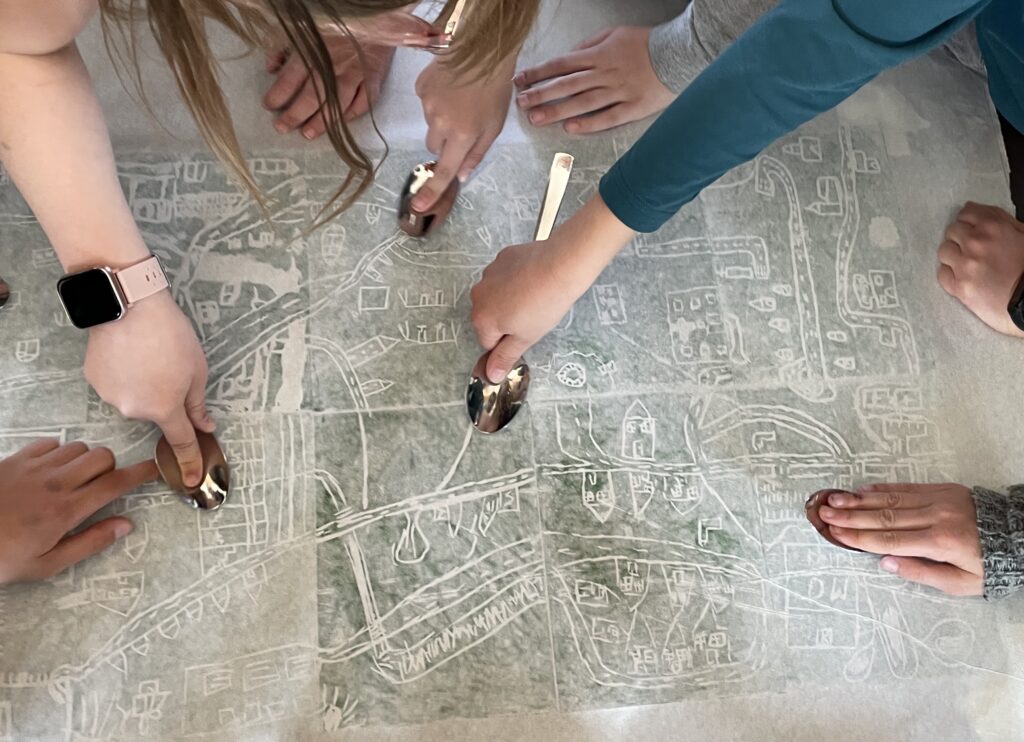
Photo: Michela Benedan
“What does a city need?” We worked with ten third grade students on a fictional city map using linoleum printing. Each child carved three lino plates, which were then joined together like a jigsaw puzzle. The collaboration between the children was central to this: Their individual drawings combined to form a larger picture. Some children got together in smaller groups to develop ideas and paths together. They were able to print the end result themselves and enjoyed the various phases of the project.
Artistic direction: Christiane Budig
Elementary school “Am Mühlberg” in Hohenthurm

Photo: Christiane Budig
In the art project, plate-sized spinning tops were built with the help of “spinning pictures”, which were produced in salad spinners. Here the children discovered color mixtures through movement – “a play of colors” was created. But the 4th grade students also tried out consciously mixing colors and patterns on the spinning top surfaces, which only begin to mix through movement. Free ink graphics were created through “thread graphics” and “ink blowing”, which generated random structures and were then further developed or supplemented through free association with pen and ink drawings. Promoting the joy of design and the creative potential of all pupils was my particular aim of the art project during this difficult pandemic period.
Artistic direction: Harriet Bünning
Borlach Community School Bad Dürrenberg
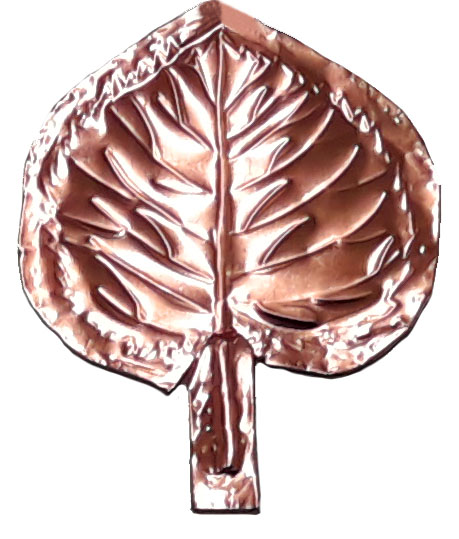
Foto: Harriet Bünning
In the “Structures” project, an autumn leaf was to be imitated and produced using the copper rubbing technique. The students worked on a thin copper sheet, which they had cut into the shape of a leaf, using a wide variety of rubbing tools. The tool for the copper rubbing technique must be handled differently than, for example, a pencil used for painting, drawing or writing. The students have learned how much force they need to use to press the rubbing tool into the copper sheet so that the desired motif is clearly and vividly deposited. The aim was to imitate the fine veins of the leaf in such a way that the viewer can understand the vitality of nature. As the resulting structures grow out of the copper sheet in relief, they can be felt by motor skills and thus expand the pupils’ perceptual experiences.
Artistic direction: Josefine Cyranka
Salbke elementary school in Magdeburg
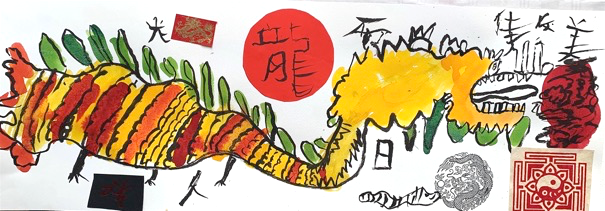
Foto: Josefine Cyranka
We have turned towards the morning sun, which is red on the horizon like on the flag of Japan. For three days, the art room at Salbke elementary school was transformed into a Japanese empire. After an introduction about previous knowledge such as: HOKAIDO, SUSHI, MIKADO, JUDO, SUMO, ORIGAMI AND KOI, we draw real dragons with original Sumi ink and real Japanese brush pens. These were supplemented by calligraphic signs and completed with collage. The precise saliva analysis of a wasp nest was used to make paper from cotton fibers.
Artistic direction: Carola Helbing-Erben
Elementary school Ostrau
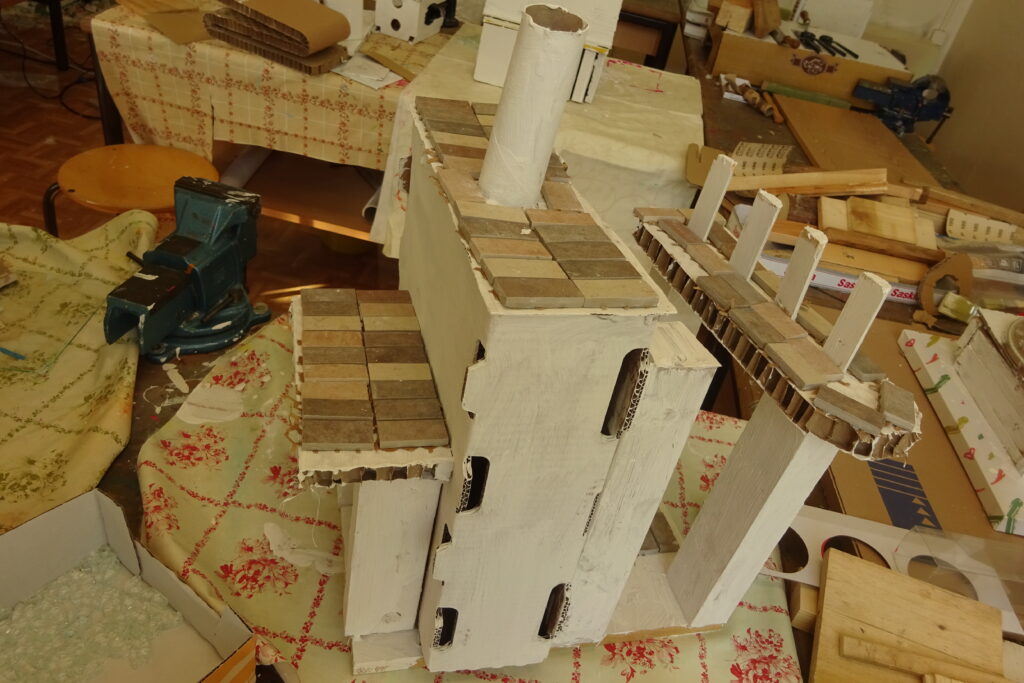
Foto: Carola Helbing-Erben
The children in a Year 4 class heard about architects and planners who built particularly quirky, funny or eye-catching houses all over the world. They saw pictures. Looking at art history, they were introduced to three artists who also or exclusively devoted themselves to architecture in their art. Fun. Niki de Saint Phalle and Hundertwasser. It was about the question of the procedure, the path until a house is usable: drawing, model, realization of the model. Numerous picture examples were presented. Our task was to build a MODEL. It was not about copying one of these artists: “MY special house” was the theme. Two rooms full of wooden parts, cardboard boxes of all sizes were ready for selection. They sawed, hammered, drilled, glued and painted. The enthusiasm could not be overlooked. Beautiful results were achieved.
Artistic direction: Holtrud Henze
Elementary school Ostrau
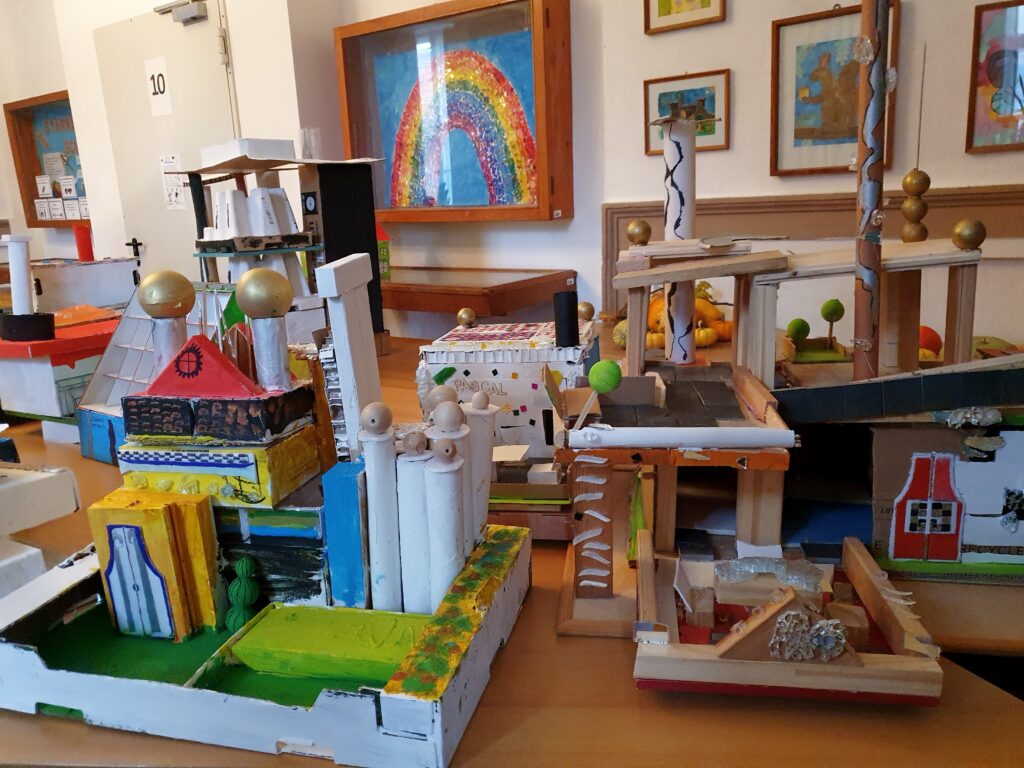
Photo: Holtrud Henze
After a short introduction to the topic, the children can put together the building materials for their model. They choose the right elements for their house from a wealth of shapes made from strips, sticks, balls and scraps of wood, as well as boxes, balls, tubes and cartons made from cardboard. This means that even the first building attempts can be playfully put together and sorted out accordingly. By gluing, folding, hammering, drilling, nailing and screwing together, the possible combinations of individual parts are tested and their possible uses checked. The shape that has now emerged gives rise to the previously unclear function of the individual houses. With different colors, materials and design elements, such as metal and wooden balls, beads and small pieces of horn and wood, the various houses are given their final and unique design. After four days of intensive work, each child can proudly present and introduce their own very special house. At the very end, all the children build a small town with their models in the entrance area of the school. Their satisfied and proud faces show their enthusiasm for the successful project.
Artistic director: Jan Herzog
Beesenstedt elementary school
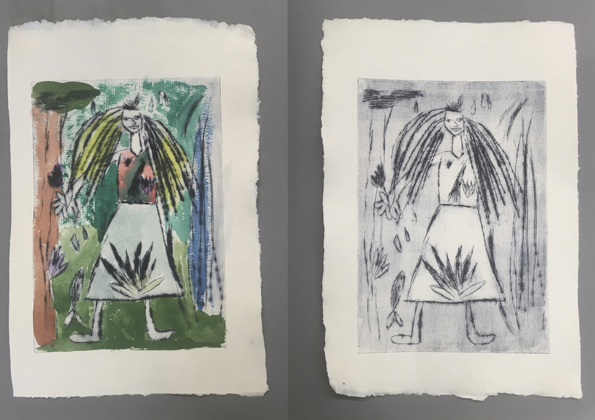
Photo: Jan Herzog
Etching. A challenging topic with third grade students – not easy, is it? No, it wasn’t easy – but it was a great challenge. This made it particularly instructive not only for pupils, but also for the artists. It is rare to see such fresh and lively etchings. As an artist, I was amazed at how important color is for the perspective of meaning when working with children. Only with color does everything really make sense. Etching project on the theme of the Rainy Druid (by Theodor Storm)
Artistic direction: Silke Hönig
Salzmünde elementary school
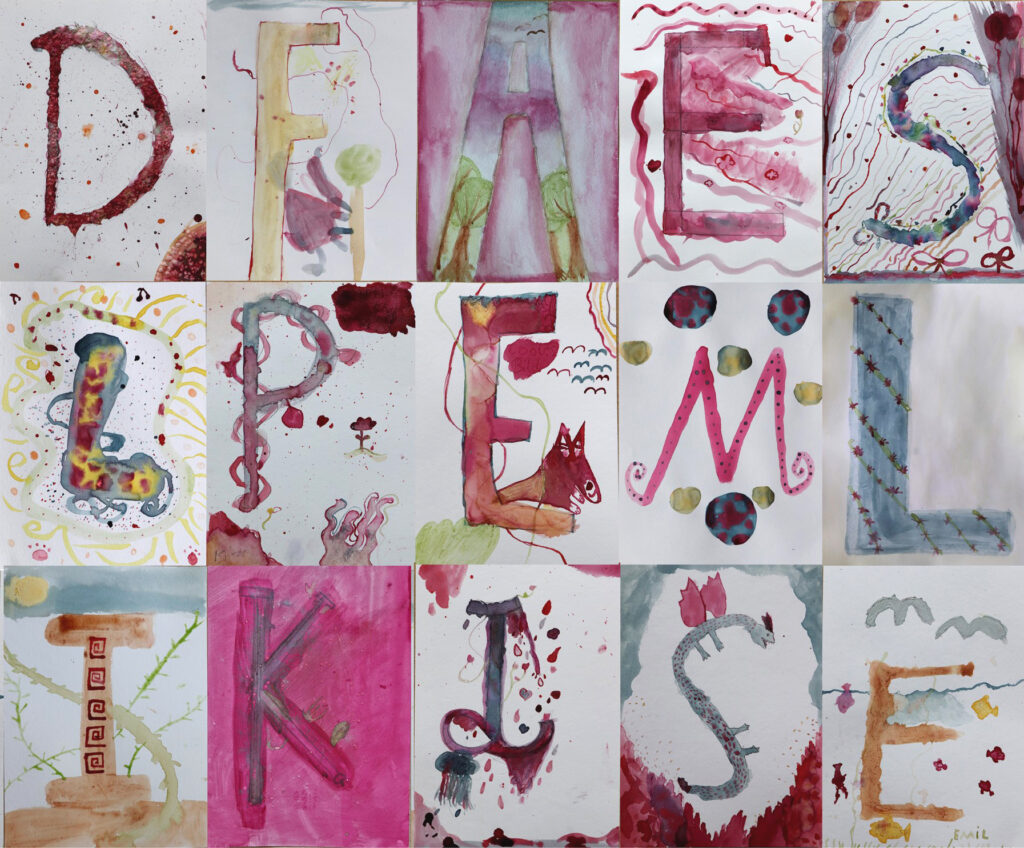
Photo: Silke Hönig
What do red cabbage, mallows and poppies have in common? Pupils from the third grade at Salzmünde elementary school set off on a journey of discovery to explore the world of natural plant colors. Unlike when using tube paints, the pupils were able to experience the process of color extraction for themselves. They learned about the coloring properties of familiar flowers, vegetables, fruits, herbs and classic dye plants that were unknown to them. Paints were obtained from fresh and dried plant material. It was rubbed, grated, boiled, extracted, experimented with, preserved, juice paint was processed into watercolors and pigments, and pezzetti were made … A centuries-old knowledge and tradition was brought to life through the senses. In the artistic and creative application of the colors, we made thematic reference to medieval book illumination. They tried out and combined wet-on-wet watercolor painting, drawing with bamboo feathers, plant printing and collaging with plant-dyed papers.
Artistic direction: Suse Kaluza
Primary school/West Neustadt/Halle (Saale)
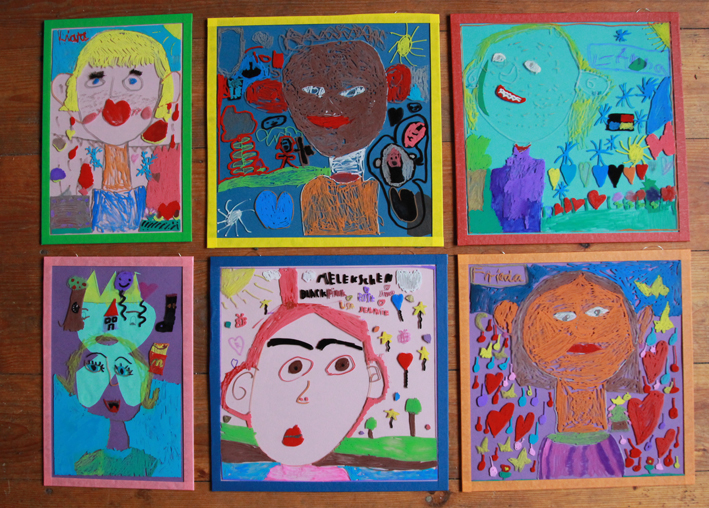
Foto: Suse Kaluza
Under the motto: “This is me – this is my school”, the children in Year 2 portrayed each other and themselves. Glass panes were used as aids through which the participants observed each other and traced with highly pigmented lacquer paints. Self-portraits were created on reflective tiles. The resulting works are permanently exhibited in the school.
Artistic direction: Juliette Kollberg
St. Franziskus Primary School Halle (Saale)
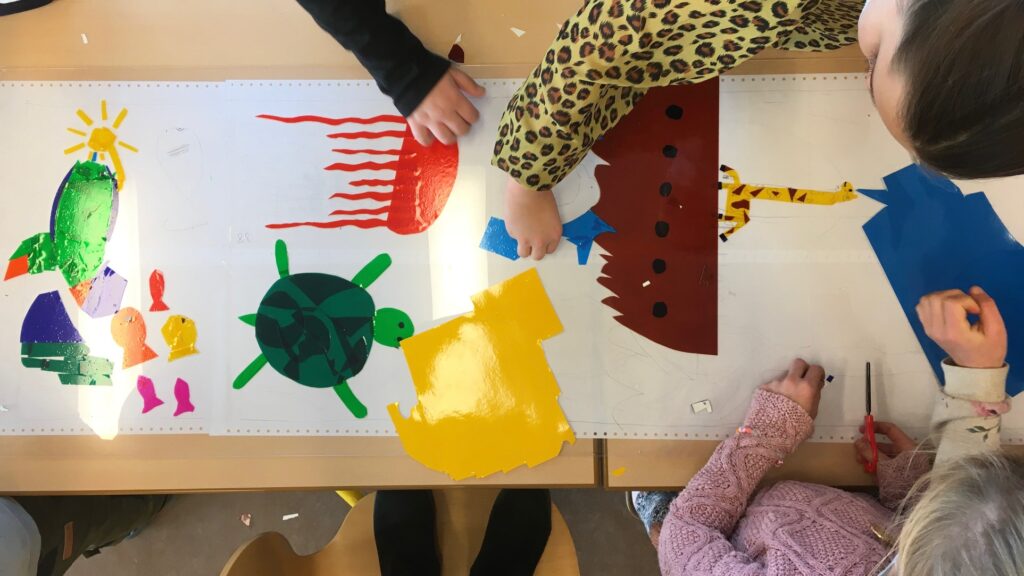
Photo: Juliette Kollberg
16 children from the Catholic elementary school in Halle created large-format window paintings for the corridor area of their school building. The project continued last year’s work and focused on the school’s namesake, Francis of Assisi, and his text “The Canticle of the Sun”. In terms of design, the focus was on examining perception from different perspectives and familiarizing oneself with new material. Above all, they experienced the material-specific intuitive handling, the playful condensation and layering. The children perceived the joint decision on the chosen symbolism and its arrangement on the overall surface and the joint creation of the motif on a picture panel as an unusual experience that strengthened the group.
Artistic direction: Thomas Leibe
FÖS Rainbow School Landsberg
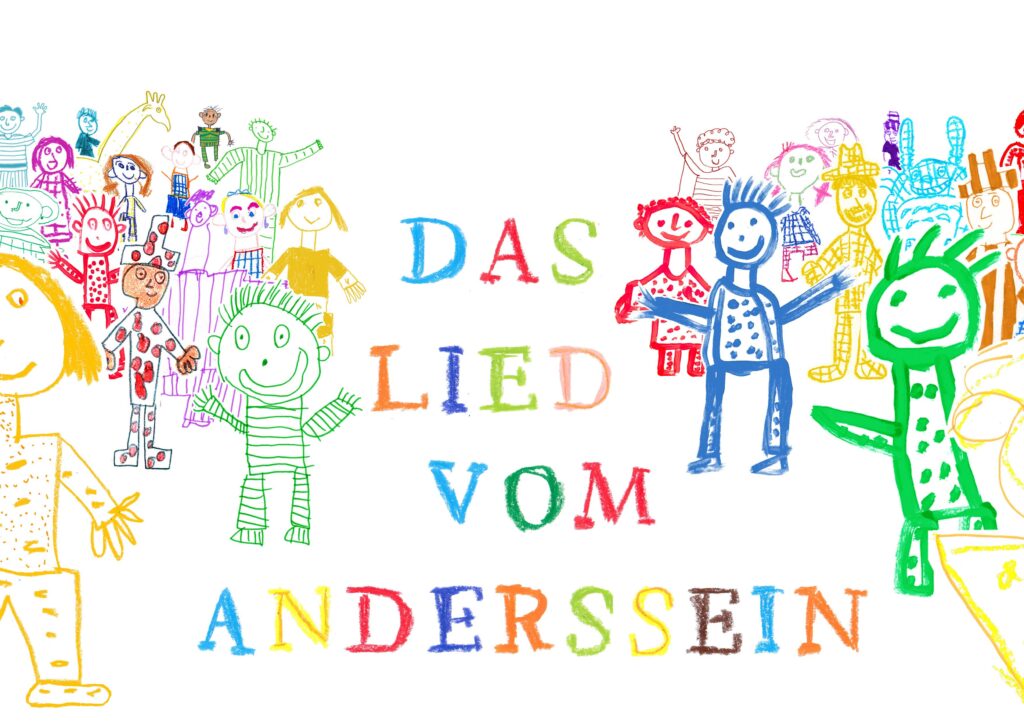
Photo: Thomas Leibe
The task: Children of different ages, developmental and skill levels are to transform a song text into a picture book. Is it possible to make the core of the song’s message sufficiently vivid to dispense with lyrics? The illustrator Thomas Leibe from Halle took on this challenge together with the pupils of the Regenbogenschule in Landsberg. It is based on Klaus W. Hoffmann’s well-known children’s song about being different, “Im Land der Blaukarierten”.
Artistic direction: Annekatrin Müller
Borlach Community School in Bad Dürrenberg
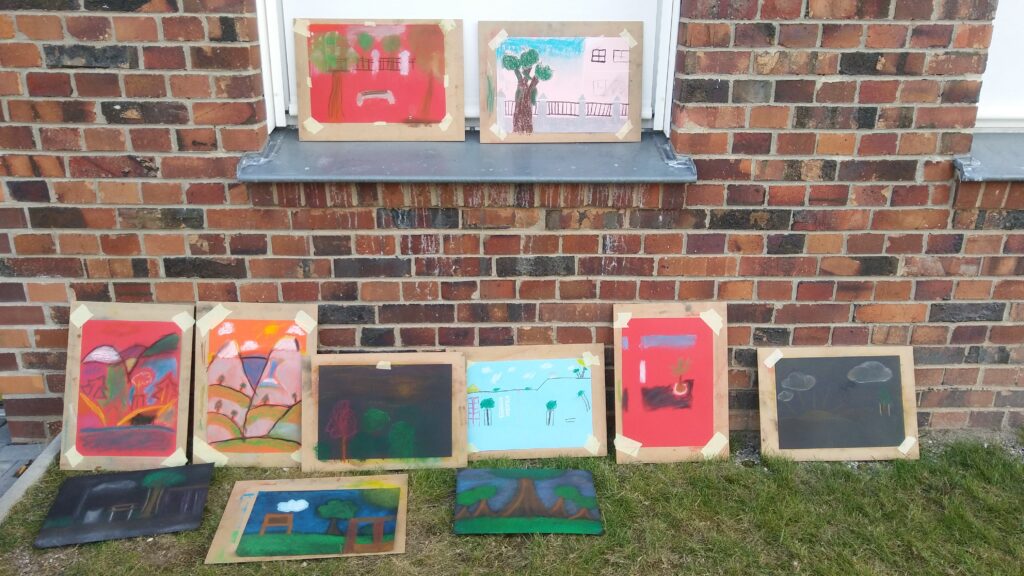
Photo: Annekatrin Müller
The project was carried out with the Borlach Community School in Bad Dürrenberg. After most of the Year 10 pupils had already gained experience with pastels in a project involving the painting of still lifes, this time the landscape in the surrounding area was to serve as a model. A new experience for many. I was amazed at how individually and creatively many students mastered this task.
Artistic direction: Sibylle Mundt
Martin Luther Protestant Primary School, Oppin
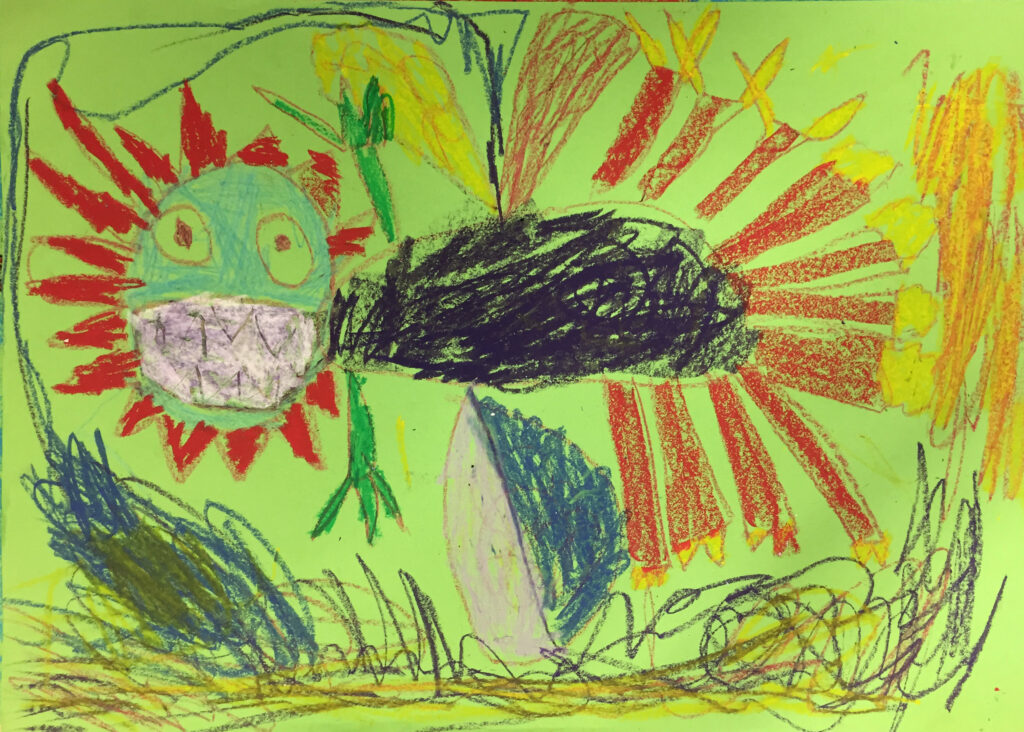
Photo: Sibylle Mundt
The pupils were asked and instructed to think up a fantasy animal and create it in A2 format using oil pastels. It was a great challenge for the children to get to know and try out the many creative possibilities of oil pastels and to create a creature that fills the entire format with as much freedom as possible. First the animals were developed. Then everyone thought about the environment in which the animal could be at home. In the end, both themes were combined in one format.
Artistic direction: Christian Nebel
Elementary school G.-E.-Lessing Halle (Saale)
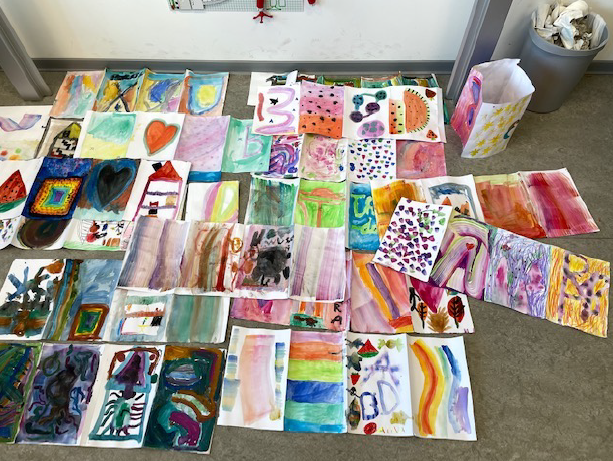
Photo: Christian Nebel
During the project, I introduced the pupils to a wide range of painting possibilities. It dealt with various basic concepts as well as painting and drawing possibilities. The newly learned and experienced technique was immediately applied in the form of name tags, masks and other shapes. The experimental use of the available resources was also addressed. Different brushes were dipped in different colors and spread on the paper in streaks. During this project period, the pupils learned that it is possible to dedicate themselves to the beginnings of visual art in a playful way, even with few and above all inexpensive means.
Artistic direction: Friederike Nottrott
Janusz Korczak School Halle
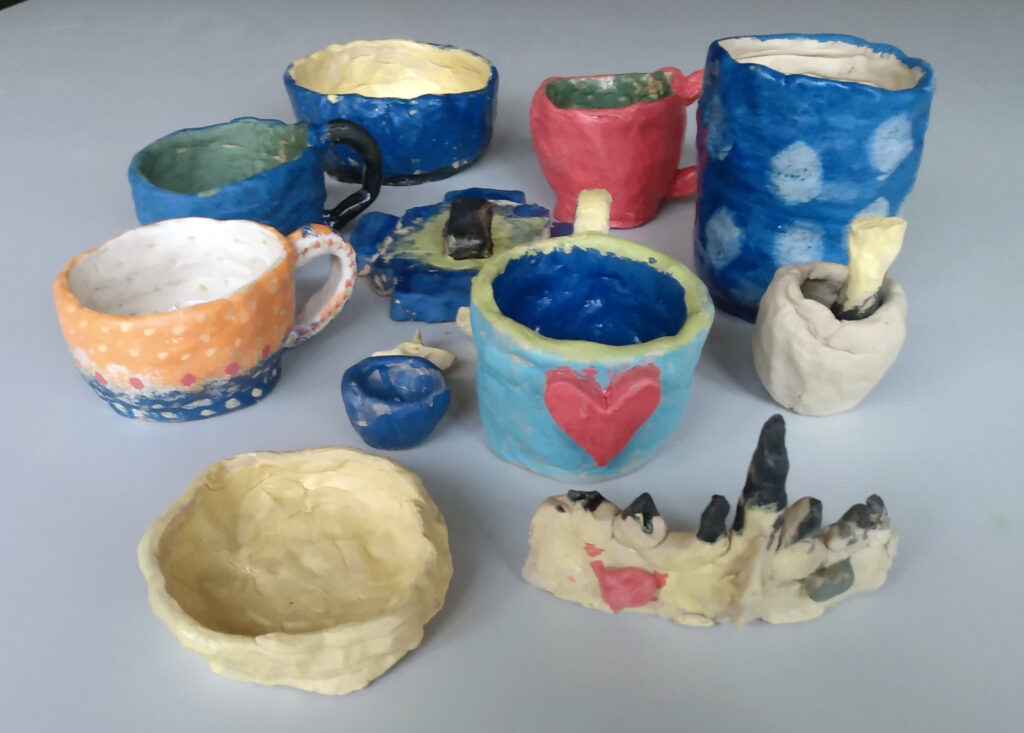
Photo: Friederike Nottrott
In order to promote the idea of the student manufactory, I wanted to use my knowledge to promote the practical implementation of ideas in ceramics. In the 20 hours of the project “Artists in Schools in Saxony-Anhalt” I was able to teach pupils how to work with ceramics.
Clay is a wonderful material that can be used in many different ways. Working with the ceramic material is a relaxing and uncomplicated activity in which you can quickly achieve a sense of achievement even without experience. I offered topics and explained a practical spectrum using sketches on the blackboard and modeling techniques. Based on this, the pupils were able to choose a design theme themselves and work on it under my guidance. We formed beads and ridges and used them to construct vessels, model them freely or roll out sheets and process them in different ways.
The result is utilitarian vessels and free objects that reflect the pupils’ field of interest.
Artistic direction: Prof. Karl Oppermann
Marianne-Buggenhagen-Schule Darlingerode
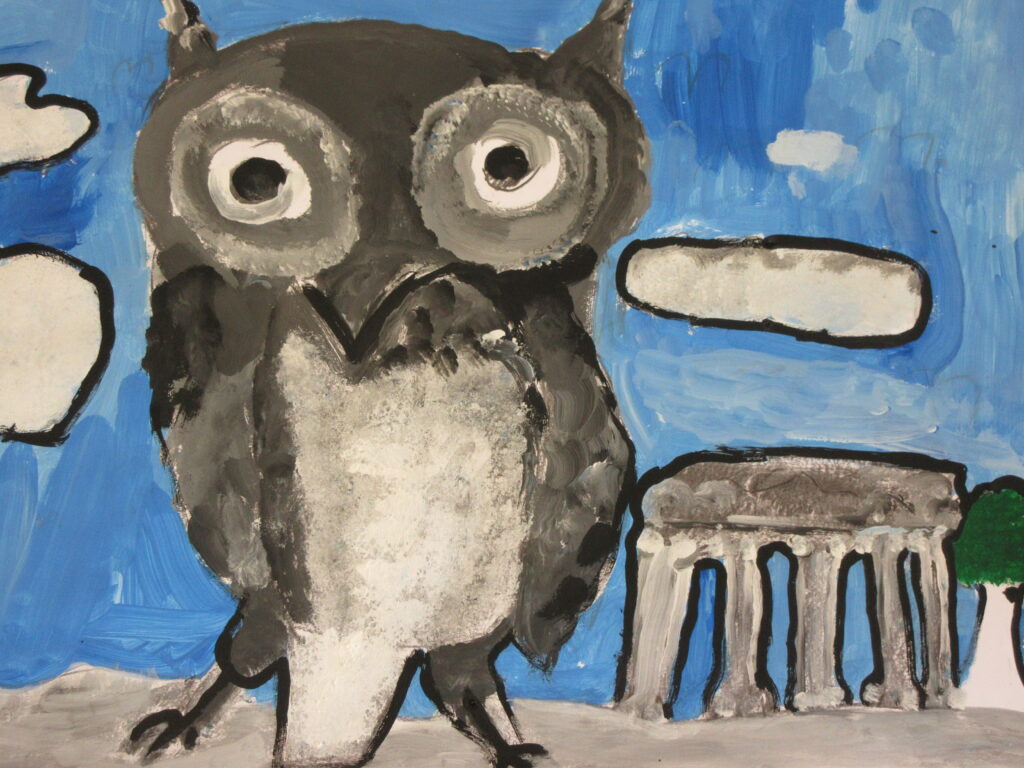
Photo: Kerstin Hoidis
“Carrying owls to Athens”; the starting point for our project was European “winged words”/proverbs. There are an astonishing number of idioms in Europe. Some of them differ in content, but they mean the same thing. This linguistic treasure is a great heritage for us Europeans and would like to be preserved and understood by all of us. “It’s raining cats and dogs”; our journey continues to England. Here we get to know the proverb for “heavy rain”. The English have been using this since at least the 17th century. The students work with charcoal and paint on large paper formats. Painting the raindrops is much easier with the special brush. But you can also get good structures with a comb.
Artistic direction: Renée Reichenbach
Levana School Eisleben
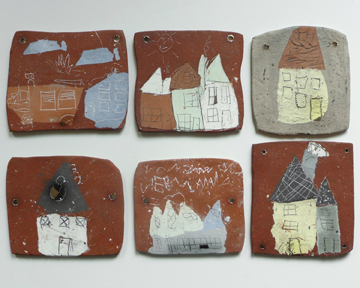
Foto: Renée Reichenbach
A ceramic project for the development of small, thematically free picture plates using a special technique in which small, thinly rolled out snippets of colored clays or dyed porcelain are rolled and hammered into a thicker clay plate like an inlay. With a scribed drawing on top, imaginative, playfully developed miniatures were created with a great deal of patience, which will ultimately be joined together to form a large mural. A challenge for the students’ manual skills too!
Artistic direction: Katrin Röder
Thomas-Müntzer-Gymnyasium Halle (Saale)
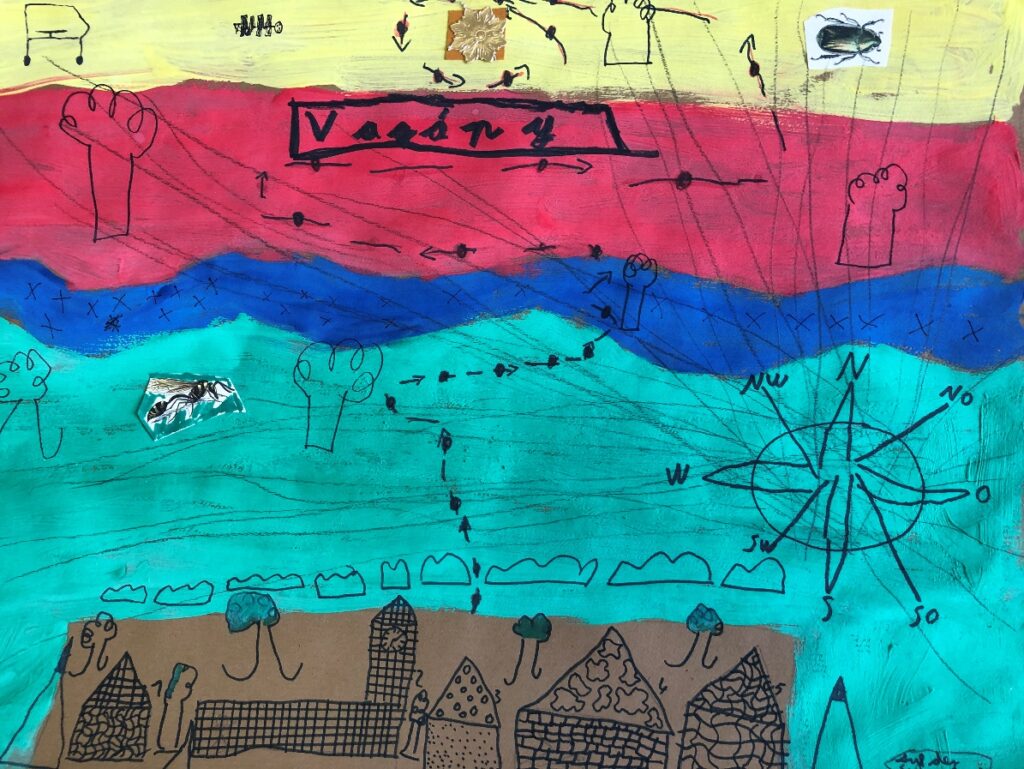
Foto: Katrin Röder
The aim was to playfully encourage the pupils’ creativity in dealing with maps as a transformation into a treasure map. An A3 map with 2 views was to be designed. A frontal view for the cartouche with city landscape and a top view for the terrain. Using lines, areas and patterns, the outline in the cartouche should first be roughly drawn and then the finer details should be added using color. The landscape should contain at least 3 colors and be marked with symbols. Other elements: rosette, coat of arms, flags and the path to the treasure.
Artistic direction: Judith Runge
Johannes Primary School Merseburg
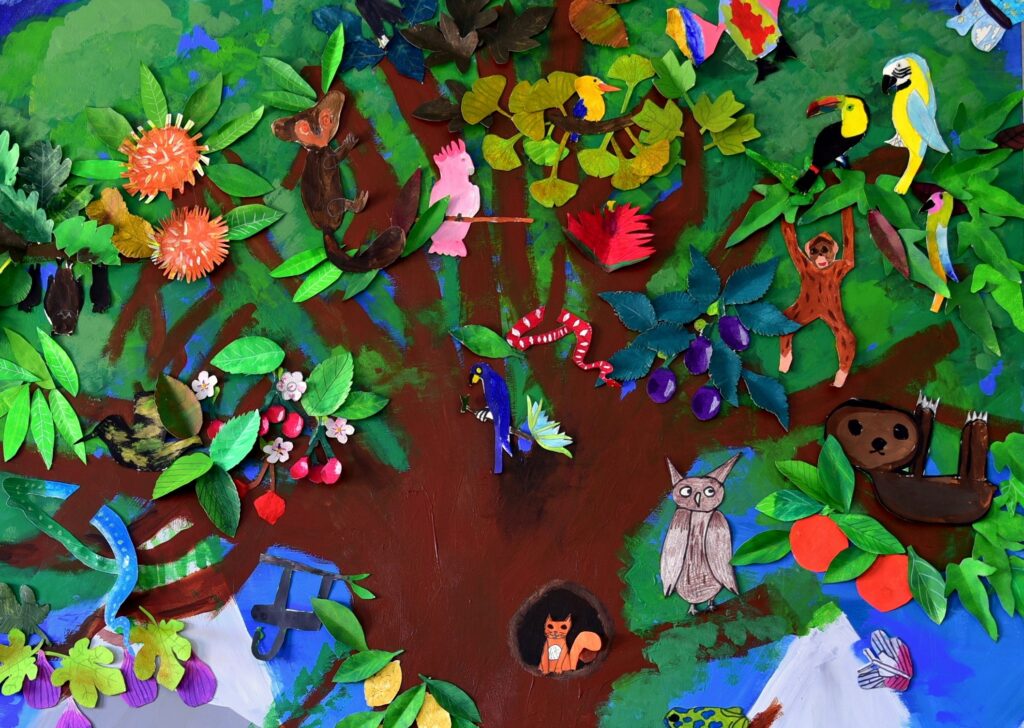
Photo: Judith Runge
A collage depicting a fantastic tree on which the most diverse types of leaves, fruits, flowers and animals come together now adorns the stairwell of the Johannes Primary School in Merseburg. In a cooperative effort, 12 pupils from Year 4 created a work of art from numerous individual pieces of cardboard painted with acrylic paint and folded. During the joint activity, the importance of trees for the natural balance and human life was discussed. The children practiced coordinating with each other to create a successful joint project.
Artistic direction: Dietmar Sauer
Special school GB “Hugo Kükelhaus” Magdeburg
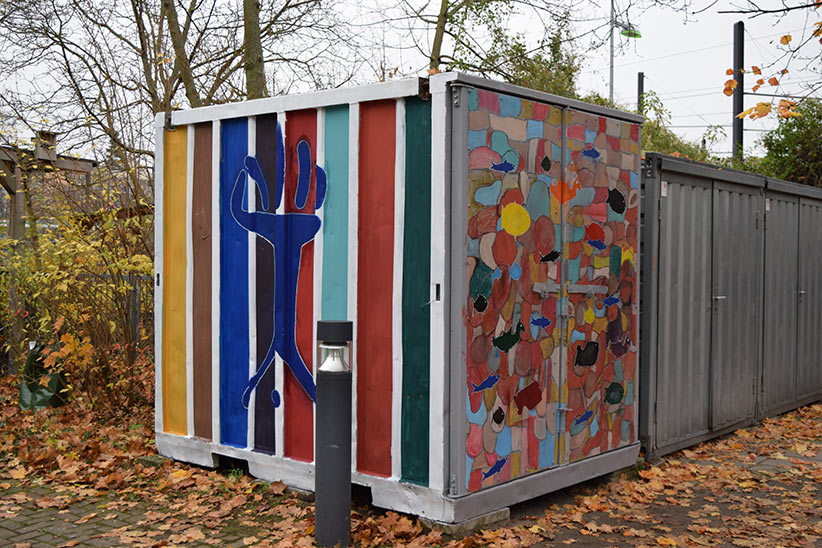
Foto: Dietmar Sauer
The topic developed was the design of the bicycle container in the outdoor area. The proposed theme was taken up by the artist. Some of the results of the previous work tasks in the training sessions were very well developed and focused on the design of the bicycle container. Exercises: Cyanotopia, monotopia with gel plates, stamp printing, fish stencils for designing the outer walls of containers, ornamental and graphic templates from the Stone Age. The best results of this work hang in the corridor area in front of the secretary’s office in the school. The container was designed by the group with the support of the supervisors.
Artistic direction: Klaus-Dieter Ullrich
Burg-Gymnasium Wettin
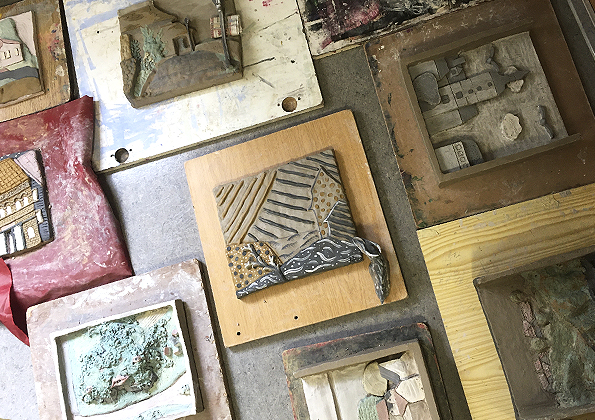
Photo: Klaus-D. Ullrich
Dedicating themselves to the theme of landscape, including the thematic expansion of views and vistas, has produced multi-layered results with the pupils of the Kunstgymnasium. The techniques of collage were taught, which were then to be continued in ceramic reliefs. The starting point was the drawing, then it was about colorful, flat overlays in the collages, then about layering in the ceramic material – from the surface to the relief…
Artistic direction: Pauline Ullrich
Beesenstedt elementary school
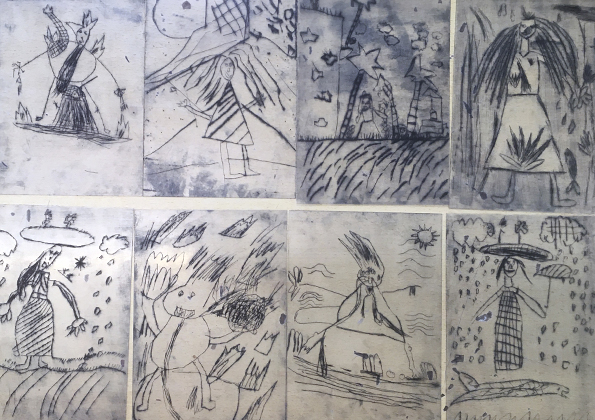
Photo: Pauline Ullrich
The Regentrude – it is not lacking in topicality. The common theme – climate – makes Theodor Storm’s fairy tale seem anything but outdated. The story of Regentrude and Feuermann as an etching – the very natural children’s drawing in the printed line is convincing, as is the hand-coloring. A great deal was achieved in a very short time – which only works with the corresponding commitment of the children involved. The children’s enthusiasm is encouraging. (Pauline Ullrich)
Artistic direction: Rosemarie Ullrich
Burg-Gymnasium Wettin

Photo: Rosemarie Ullrich
superimpositions, textures, – layer structure in sculpture. This is demanding and requires a lot of planning – you have to think before your hands can form. It is therefore all the more pleasing to see how the ceramic reliefs – including the techniques of slab construction, inlay technique and painting with engobes – were mastered in the relatively short time available.
Artistic direction: Anna Zeitler
Reinhardt-Lakomy School
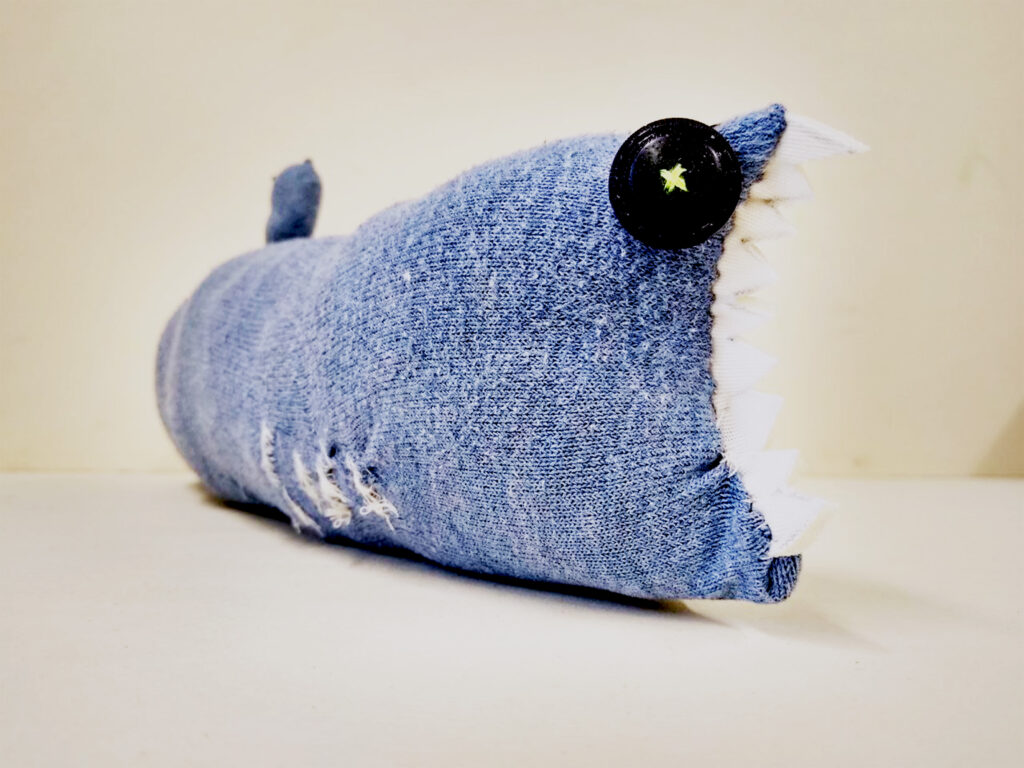
Photos: Anna Zeitler
My power animal: The 9 students were in the 8th grade. At the beginning of the project week, the pupils playfully explored their strengths and weaknesses and learned and practiced basic sewing skills. Building on these insights and skills, the students designed and realized their own power animal. The power animals were made from individual socks and gloves, scraps of wool and fabric and buttons. This resulted in creative and diverse power animals over the course of the week. On the last day, the students rehearsed a short play and performed it for the group, and we also had a small exhibition where we admired all the results of our work and the finished power animals and looked back on the week.
